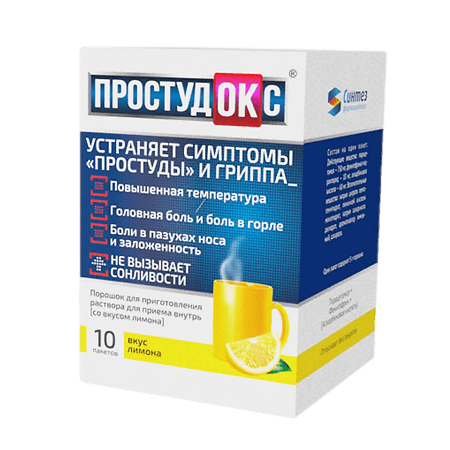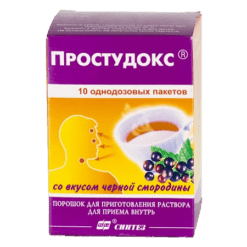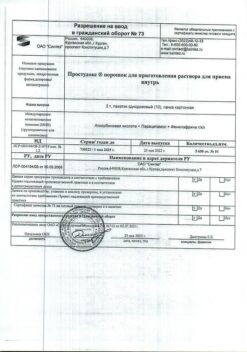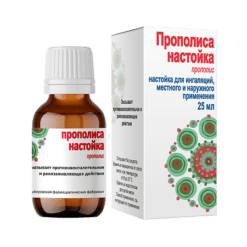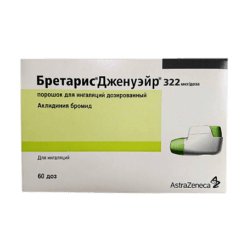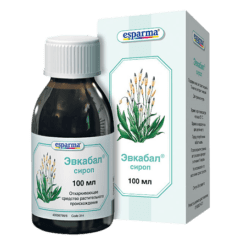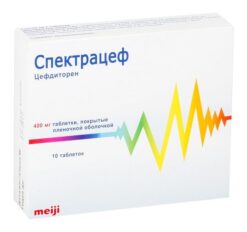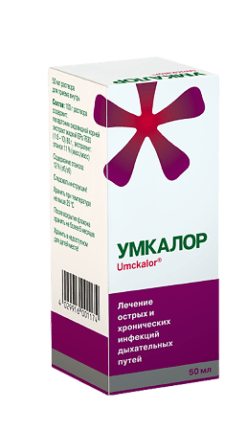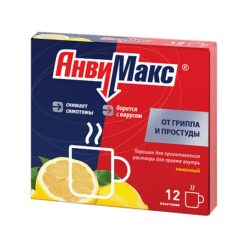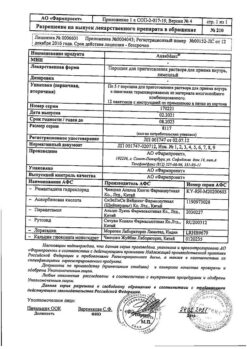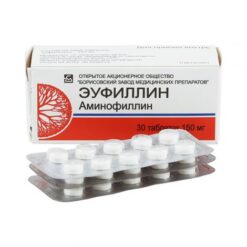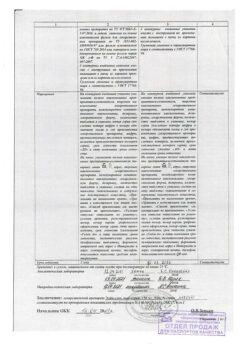No products in the cart.
Prostudox lemon, 5 g 10 pcs
€11.80 €9.83
Description
Pharmacotherapeutic group:Anallergic and “cold” remedy (analgesic non-narcotic + alpha-adrenomimetic + vitamin).
ATX code: N02BE51
Pharmacological properties
A combined remedy, the action of which is due to its constituent components.
Pharmacodynamics
Paracetamol is an analgesic and antipyretic. Its mechanism of action is thought to be the inhibition of prostaglandin synthesis, mainly in the central nervous system.
It has practically no effect on the synthesis of prostaglandins in the peripheral tissues, does not change the water-electrolyte metabolism and does not damage the mucous membrane of the gastro-intestinal tract. This property of paracetamol makes the drug particularly suitable for patients with a history of gastrointestinal diseases (e.g., patients with a history of gastrointestinal bleeding or elderly patients) or patients taking concomitant medication in which inhibition of peripheral prostaglandin synthesis may be undesirable.
Phenylephrine hydrochloride is a sympathomimetic agent aimed at stimulation of adrenoreceptors (mainly α-adrenoreceptors), which leads to reduction of nasal mucosal edema and facilitation of nasal breathing.
Ascorbic acid (vitamin C) replenishes the increased need for vitamin C during “colds” and flu, especially at the initial stages of the disease. The ingredients do not cause drowsiness or impair concentration.
Pharmacokinetics
Absorption and distribution
The absorption of paracetamol in the gastrointestinal tract is high. Time to reach maximum plasma concentration is 0.5-2 hours; maximum plasma concentration is 5-20 µg/ml. Binding with plasma proteins is 15%. It penetrates through the blood-brain barrier.
Phenylephrine hydrochloride is unevenly absorbed from the gastrointestinal tract. Maximum plasma concentrations are reached between 45 min and 2 h. There are no data on distribution.
Ascorbic acid is quickly absorbed from the gastrointestinal tract and distributed throughout the body. The binding to plasma proteins is 25%.
Metabolism
Paracetamol is metabolized mainly in the liver. 90-95 % by three main pathways: 80% undergo conjugation reactions with glucuronic acid and sulfates to form inactive metabolites; 17% undergo hydroxylation to form 8 active metabolites, which conjugate with glutathione to form already inactive metabolites. In case of glutathione deficiency these metabolites can block enzyme systems of hepatocytes and cause their necrosis. The CYP2E1 isoenzyme is also involved in metabolism of the drug.
Phenylephrine hydrochloride undergoes primary metabolism by monoamine oxidases in the intestine and liver. Thus, the bioavailability of phenylephrine is reduced with oral administration.
There are no data on ascorbic acid metabolism.
Elimation
Paracetamol is excreted by the kidneys as metabolites, mainly glucuronide and sulfate conjugates, less than 5% is excreted unchanged. The elimination half-life is 1-4 hours. In elderly patients the drug clearance is decreased and the half-life is prolonged, but no dose adjustment is required. Phenylephrine hydrochloride is excreted by the kidneys almost completely in the form of sulfate conjugates. The elimination period is 2-3 hours.
When administered in doses that exceed the body’s need for ascorbic acid, ascorbic acid is excreted by the kidneys as metabolites.
Indications
Indications
The drug is used as a temporary remedy for symptoms of “colds” and flu, including:
– fever;
– headache;
– chills;
– joint and muscle pain;
– sinus pain and congestion;
– sore throat.
Active ingredient
Active ingredient
Composition
Composition
Effective ingredients:
Paracetamol – 750 mg,
Phenylephrine hydrochloride – 10 mg,
Ascorbic acid – 60 mg.
Auxiliary substances:sodium citrate pentahydrate (sodium citric acid 5.5-water), citric acid monohydrate, sodium saccharinate dihydrate, lemon flavoring (food powder “Lemon” flavoring), sucrose.
How to take, the dosage
How to take, the dosage
For oral administration.
Do not exceed the recommended dose!
Have to use the lowest dose necessary to achieve an effect for the shortest possible treatment period!
The minimum interval between doses of Prostudox® should be at least 4 hours.
Pour the contents of 1 sachet into a mug, pour about 250 ml of hot water and mix thoroughly. If necessary, add cold water and sugar.
Adults and children over 12 years
1 sachet every 4-6 hours, but no more than 4 sachets per day. The maximum duration of use of the drug without consulting a physician should be no more than 5 days.
It is not recommended to use the drug as a antipyretic for more than 3 days without physician’s consultation.
The use with other paracetamol-containing agents, decongestants and agents for relief of symptoms of “colds” and flu, as well as with ethanol-containing agents and drinks is not recommended.
If symptoms persist while taking the drug, you should see your doctor.
If you exceed the recommended dose, seek medical attention immediately, even if you feel well, as there is a risk of delayed serious liver damage. Paracetamol overdose may cause hepatic and/or renal failure.
Special patient groups
. Patients with impaired renal function should consult a physician before using Prostudox®. The limitations associated with the use of preparations containing this combination of active ingredients in patients with impaired renal function are mainly due to the paracetamol content of the drug.
Patients with hepatic impairment
Patients with hepatic impairment should consult their physician before using Prostudox®. The limitations associated with the use of preparations containing this combination of active ingredients in patients with impaired liver function are primarily due to the paracetamol content of the drug.
Interaction
Interaction
Potentially clinically significant drug interactions are presented below (see sections “Contraindications” and “Cautions”).
Paracetamol when taken regularly for a long time increases the effect of indirect anticoagulants (warfarin and other coumarins), which increases the risk of bleeding. Episodic administration of a single dose of the drug has no significant effect on their effect.
The inducers of microsomal oxidation enzymes in the liver (barbiturates, diphenine, carbamazepine, rifampicin, zidovudine, phenytoin, ethanol, flumecinol, phenylbutazone and tricyclic antidepressants) increase the risk of hepatotoxic effect in overdose and concomitant use with paracetamol.
Microsomal oxidation inhibitors (cimetidine) reduce the risk of hepatotoxic effects.
Halothane increases the risk of ventricular arrhythmias.
Paracetamol reduces the effectiveness of diuretics and uricosuric drugs. Metoclopramide and domperidone increase, and colestyramine decreases the rate of absorption of paracetamol.
Paracetamol increases the effects of MAO inhibitors, sedatives, ethanol. Concomitant use of paracetamol and alcoholic beverages increases the risk of liver damage and acute pancreatitis.
Phenylephrine when taken with MAO inhibitors may lead to increased blood pressure.
Phenylephrine may decrease the effectiveness of beta-adrenal blockers and other hypotensive drugs (including such drugs as debrisoquine, guanethidine, reserpine, methyldopa) and may increase the risk of hypertension and cardiovascular events.
Tricyclic antidepressants (e.g., amitriptyline) increase the sympathomimetic effects of phenylephrine and may increase the risk of cardiovascular side effects. Concomitant use of halothane with phenylephrine increases the risk of ventricular arrhythmia. Phenylephrine reduces the hypotensive effect of guanethidine, which in turn increases the alpha-adrenergic stimulating activity of phenylephrine.
Antidepressants, antiparkinsonics, antipsychotics, phenothiazine derivatives increase the risk of urinary retention, dry mouth, constipation.
The concomitant use of glucocorticosteroids with phenylephrine increases the risk of glaucoma.
The concomitant use of digoxin and other cardiac glycosides may increase the risk of heart rhythm disturbances and heart attack.
The concomitant use of phenylephrine with sympathomimetic amines may increase the risk of cardiovascular side effects. Concomitant use of phenylephrine and ergot alkaloids (e.g., ergotamine and methysergide) may increase the risk of ergotism.
Ascorbic acid increases the risk of crystalluria when treated with salicylates and short-acting sulfonamides, slows renal excretion of acids, increases excretion of drugs that are alkaline (including alkaloids), and reduces the blood concentration of oral contraceptives.
Ethanol promotes the development of acute pancreatitis.
Myelotoxic drugs increase the manifestation of hematotoxicity of the drug.
Special Instructions
Special Instructions
If no improvement is seen while taking the drug or if the first signs of overdose appear, even if there are no clear symptoms of poisoning, it is necessary to see a doctor immediately.
The drug contains paracetamol; it should not be taken together with other paracetamol-containing drugs, as well as non-opioid analgesics, NSAIDs (sodium metamisole, acetylsalicylic acid, ibuprofen etc.
Synopsis
Synopsis
Packet contents:
Lemon-flavored powder from white or white with a yellowish hue to light yellow or light brown with lemon flavor, prone to clumping. White, yellow or brown inclusions are allowed.
Description of reconstituted solution
“Lemon-flavored” is a colorless or light yellow to yellow or light brown opalescent solution with lemon odor.
Contraindications
Contraindications
– hypersensitivity to paracetamol, phenylephrine, ascorbic acid (vitamin C) or any other component of the drug;
– severe hepatic and renal dysfunction;
– hyperthyroidism (including thyrotoxicosis.
– hyperthyroidism (including thyrotoxicosis);
– diabetes mellitus and glucose/isomaltase deficiency, with a rare hereditary disorder of fructose intolerance, glucose-galactose malabsorption, becauseк.
– glucose-6-phosphate dehydrogenase deficiency;
– heart disease (with severe aortic stenosis, acute myocardial infarction, tachyarrhythmia);
– arterial hypertension;
– concomitant use of tricyclic antidepressants, beta-adrenoblockers, monoamine oxidase inhibitors (MAOIs), including those inhibitors that are not inhibited.Ñ. up to 14 days after their withdrawal;
– concomitant use of other paracetamol-containing drugs, decongestants, non-narcotic analgesics, non-steroidal anti-inflammatory drugs, drugs to relieve symptoms of “colds”, flu and nasal congestion, appetite-regulating drugs, amphetamine-like psychostimulants, barbiturates, antiepileptic drugs, rifampicin, chloramphenicol (see “Interaction with other psychotropic medications”).
– concomitant use of ethanol-containing drinks and medicinal products;
– chronic alcoholism;
– prostatic hyperplasia;
– closed-angle glaucoma;
– pregnancy and breastfeeding period;
– under 12 years of age.
Cautions
If you have any of the above diseases/conditions/risk factors, always consult your doctor before taking this medicine:
– benign hyperbilirubinemia;
– mild to moderate hepatic and renal dysfunction;
– alcoholic liver disease;
– stenotic peptic ulcer or duodenal ulcer;
– prostate disease and urinary problems;
– cardiovascular disease, including high blood pressure, obliterating vascular disease (Raynaud’s Syndrome);
– pheochromocytoma;
– having severe infections, becauseк.
– the presence of severe infections because taking the drug may increase the risk of metabolic acidosis;
– glutathione deficiency (particularly in extremely malnourished patients with anorexia, chronic alcoholism, or patients with a low body mass index);
– concomitant administration of digoxin and cardiac glycosides, ergot alkaloids (e.g., ergotamine or methysergide).
Side effects
Side effects
The drug is usually well tolerated in the recommended doses.
The following adverse reactions have been identified spontaneously during post-registration use of the drug.
The adverse reactions are classified by body system and according to the frequency of development. The incidence of adverse reactions is defined as follows: very common (â¥1/10), common (â¥1/100 and <1/10), infrequent (â¥1/1000 and <1/100), rare (â¥1/10 000 and <1/1000), very rare (<10 000), frequency unknown (frequency cannot be estimated based on available data).
Paracetamol
Paracetamol rarely has side effects.
Disorders of the blood and lymphatic system
Very rare: thrombocytopenia, leukopenia, agranulocytosis.
Disorders of the immune system
Very rare: Anaphylactic shock, skin hypersensitivity reactions, including, among others, skin rash, urticaria, angioedema (Quincke’s edema), Stevens-Johnson syndrome, toxic epidermal necrolysis.
Disorders of the respiratory system, thorax and mediastinum
Very rare: bronchospasm in patients with hypersensitivity to acetylsalicylic acid and other nonsteroidal anti-inflammatory drugs.
Liver and biliary tract disorders
Very rare: liver function disorders.
Kidney and urinary tract disorders
Long-term use of the drug in doses greater than recommended increases the likelihood of nephrotoxic effects.
Phenylephrine
Immune system disorders
Rarely: Hypersensitivity reactions, urticaria, allergic dermatitis.
Mental disorders
Often: nervousness
Nervous system disorders
Often: headache, dizziness, insomnia.
Visual organ disorders
Rarely: mydriasis, acute onset of glaucoma in most cases in patients with closed-angle glaucoma.
Cardiovascular disorders
Often: increased blood pressure.
Rarely: tachycardia, palpitations, which subside immediately after discontinuation of the drug.
Gastrointestinal tract disorders
Often: nausea, vomiting.
Skin and subcutaneous tissue disorders
Very rare: rash.
Kidney and urinary tract disorders
Rarely: dysuria, urinary retention in patients with bladder outlet obstruction with prostatic hypertrophy.
Ascorbic acid
.Blood and lymphatic system disorders
Frequency unknown: Thrombocytosis, hyperprothrombinemia, erythropenia, neutrophilic leukocytosis, hypokalemia.
Immune system disorders
Prevalence unknown: allergic reactions (skin rash, skin hyperemia).
Gastrointestinal tract disorders
Prevalence unknown: irritation of the gastrointestinal mucosa.
Moderate pollyacuria may occur when taking ascorbic acid more than 600 mg/day. If any of these adverse reactions occur, stop taking the drug immediately and see your doctor as soon as possible.
If any of the adverse reactions listed in the instructions worsen, or if you notice other adverse reactions not listed in the instructions, tell your doctor.
Overdose
Overdose
The drug should only be taken in the recommended doses!
If an overdose is suspected, even if you feel well, you should stop using the drug and see a doctor immediately, as there is a risk of delayed serious liver damage and hospitalization may be required.
An overdose is usually caused by paracetamol.
Paracetamol
Symptoms
.An overdose of paracetamol can lead to liver failure, which may require a liver transplant or death.
For 24 hours, pale skin, decreased appetite, nausea, vomiting, abdominal pain, sweating may occur. Clinical signs of liver damage usually develop within 24-48 hours and reach their maximum in 4-6 days. There may be signs of impaired glucose metabolism and metabolic acidosis. Toxic effects in adults are possible after ingestion of more than 10 g of paracetamol: increased activity of “hepatic” transaminases. Acute pancreatitis has been observed, usually with impaired liver function and liver toxicity. Acute renal failure with acute tubular necrosis, which is diagnosed by severe pain in the lumbar region, hematuria and proteinuria, may develop without severe liver dysfunction. There have been reports of cases of cardiac arrhythmias in paracetamol overdose.
Ingestion of 5 g or more of paracetamol may lead to liver damage in patients with the following risk factors:
– prolonged treatment with carbamazepine, phenobarbital, phenytoin, primidone, rifampicin, St. John’s wort preparations, or other drugs that stimulate liver enzymes;
– regular consumption of alcohol in excessive amounts;
– glutathione deficiency (due to nutritional disorders, cystic fibrosis, HIV infection, starvation, exhaustion).
At the first sign of overdose, seek immediate medical attention, even if there are no clear symptoms of poisoning.
The symptoms of phenylephrine overdose are similar to the manifestations of side effects. In addition: irritability, headache, dizziness, insomnia, increased excitability, increased blood pressure, nausea, vomiting, reflex bradycardia. In severe cases of overdose, hallucinations, confusion, seizures, arrhythmia may develop. It should be taken into account that the appearance of clinically significant symptoms of phenylephrine overdose when taking the drug is always associated with severe liver damage against overdose of paracetamol.
Treatment
Symptomatic therapy, in severe arterial hypertension the use of alpha-adrenoblockers such as phentolamine.
Ascorbic acid
Symptoms
. High doses of ascorbic acid (more than 3000 mg) may cause temporary osmotic diarrhea and gastrointestinal disturbances such as nausea and stomach discomfort. It should be taken into account that the appearance of clinically significant symptoms of ascorbic acid overdose when taking the drug is always associated with severe liver damage in the background of paracetamol overdose.
Treatment
Symptomatic, forced diuresis.
Pregnancy use
Pregnancy use
Similarities
Similarities
Additional information
| Shelf life | 3 years. Do not use after the expiration date. |
|---|---|
| Conditions of storage | At the temperature not more than 25 °С in the original package (bags in the package). Keep out of reach of children. |
| Manufacturer | Sintez OAO, Russia |
| Medication form | Powder for preparation of solution for oral administration |
| Brand | Sintez OAO |
Other forms…
Related products
Buy Prostudox lemon, 5 g 10 pcs with delivery to USA, UK, Europe and over 120 other countries.

